technical specifications Seat Altea Freetrack 2012 Owner's Manual
[x] Cancel search | Manufacturer: SEAT, Model Year: 2012, Model line: Altea Freetrack, Model: Seat Altea Freetrack 2012Pages: 297, PDF Size: 4.31 MB
Page 6 of 297
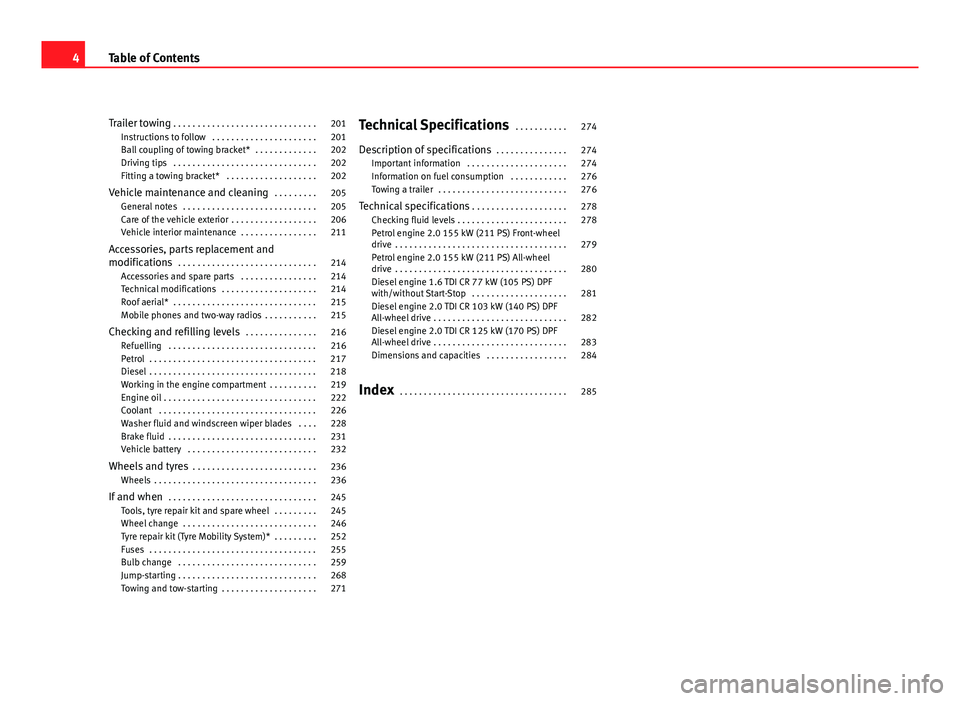
Trailer towing . . . . . . . . . . . . . . . . . . . . . . . . . . . . . . 201
Instructions to follow . . . . . . . . . . . . . . . . . . . . . . 201
Ball coupling of towing bracket* . . . . . . . . . . . . . 202
Driving tips . . . . . . . . . . . . . . . . . . . . . . . . . . . . . . 202
Fitting a towing bracket* . . . . . . . . . . . . . . . . . . . 202
Vehicle maintenance and cleaning . . . . . . . . . 205
General notes . . . . . . . . . . . . . . . . . . . . . . . . . . . . 205
Care of the vehicle exterior . . . . . . . . . . . . . . . . . . 206
Vehicle interior maintenance . . . . . . . . . . . . . . . . 211
Accessories, parts replacement and
modifications . . . . . . . . . . . . . . . . . . . . . . . . . . . . . 214
Accessories and spare parts . . . . . . . . . . . . . . . . 214
Technical modifications . . . . . . . . . . . . . . . . . . . . 214
Roof aerial* . . . . . . . . . . . . . . . . . . . . . . . . . . . . . . 215
Mobile phones and two-way radios . . . . . . . . . . . 215
Checking and refilling levels . . . . . . . . . . . . . . . 216
Refuelling . . . . . . . . . . . . . . . . . . . . . . . . . . . . . . . 216
Petrol . . . . . . . . . . . . . . . . . . . . . . . . . . . . . . . . . . . 217
Diesel . . . . . . . . . . . . . . . . . . . . . . . . . . . . . . . . . . . 218
Working in the engine compartment . . . . . . . . . . 219
Engine oil . . . . . . . . . . . . . . . . . . . . . . . . . . . . . . . . 222
Coolant . . . . . . . . . . . . . . . . . . . . . . . . . . . . . . . . . 226
Washer fluid and windscreen wiper blades . . . . 228
Brake fluid . . . . . . . . . . . . . . . . . . . . . . . . . . . . . . . 231
Vehicle battery . . . . . . . . . . . . . . . . . . . . . . . . . . . 232
Wheels and tyres . . . . . . . . . . . . . . . . . . . . . . . . . . 236
Wheels . . . . . . . . . . . . . . . . . . . . . . . . . . . . . . . . . . 236
If and when . . . . . . . . . . . . . . . . . . . . . . . . . . . . . . . 245
Tools, tyre repair kit and spare wheel . . . . . . . . . 245
Wheel change . . . . . . . . . . . . . . . . . . . . . . . . . . . . 246
Tyre repair kit (Tyre Mobility System)* . . . . . . . . . 252
Fuses . . . . . . . . . . . . . . . . . . . . . . . . . . . . . . . . . . . 255
Bulb change . . . . . . . . . . . . . . . . . . . . . . . . . . . . . 259
Jump-starting . . . . . . . . . . . . . . . . . . . . . . . . . . . . . 268
Towing and tow-starting . . . . . . . . . . . . . . . . . . . . 271 Technical Specifications
. . . . . . . . . . . 274
Description of specifications . . . . . . . . . . . . . . . 274
Important information . . . . . . . . . . . . . . . . . . . . . 274
Information on fuel consumption . . . . . . . . . . . . 276
Towing a trailer . . . . . . . . . . . . . . . . . . . . . . . . . . . 276
Technical specifications . . . . . . . . . . . . . . . . . . . . 278
Checking fluid levels . . . . . . . . . . . . . . . . . . . . . . . 278
Petrol engine 2.0 155 kW (211 PS) Front-wheel
drive . . . . . . . . . . . . . . . . . . . . . . . . . . . . . . . . . . . . 279
Petrol engine 2.0 155 kW (211 PS) All-wheel
drive . . . . . . . . . . . . . . . . . . . . . . . . . . . . . . . . . . . . 280
Diesel engine 1.6 TDI CR 77 kW (105 PS) DPF
with/without Start-Stop . . . . . . . . . . . . . . . . . . . . 281
Diesel engine 2.0 TDI CR 103 kW (140 PS) DPF
All-wheel drive . . . . . . . . . . . . . . . . . . . . . . . . . . . . 282
Diesel engine 2.0 TDI CR 125 kW (170 PS) DPF
All-wheel drive . . . . . . . . . . . . . . . . . . . . . . . . . . . . 283
Dimensions and capacities . . . . . . . . . . . . . . . . . 284
Index . . . . . . . . . . . . . . . . . . . . . . . . . . . . . . . . . . . 285
4Table of Contents
Page 8 of 297
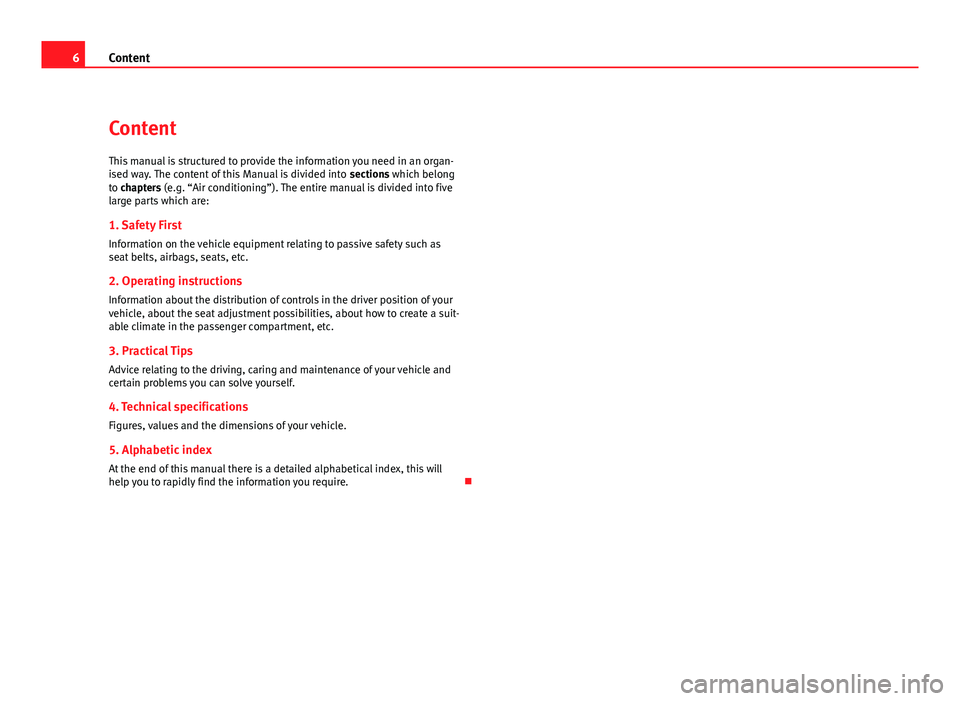
6Content
Content
This manual is structured to provide the information you need in an organ-
ised way. The content of this Manual is divided into sections which belong
to chapters (e.g. “Air conditioning”). The entire manual is divided into five
large parts which are:
1. Safety First Information on the vehicle equipment relating to passive safety such as
seat belts, airbags, seats, etc.
2. Operating instructions
Information about the distribution of controls in the driver position of your
vehicle, about the seat adjustment possibilities, about how to create a suit-
able climate in the passenger compartment, etc.
3. Practical Tips
Advice relating to the driving, caring and maintenance of your vehicle and
certain problems you can solve yourself.
4. Technical specifications
Figures, values and the dimensions of your vehicle.
5. Alphabetic index
At the end of this manual there is a detailed alphabetical index, this will
help you to rapidly find the information you require.
Page 9 of 297
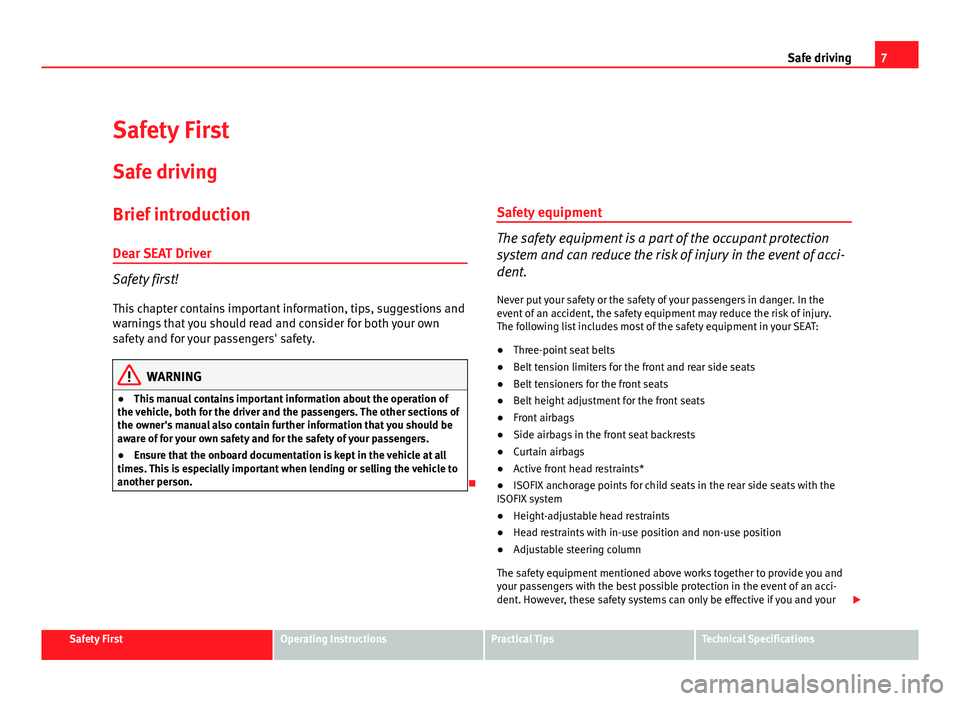
7
Safe driving
Safety First
Safe driving
Brief introduction
Dear SEAT Driver
Safety first! This chapter contains important information, tips, suggestions and
warnings that you should read and consider for both your own
safety and for your passengers' safety.
WARNING
● This manual contains important information about the operation of
the vehicle, both for the driver and the passengers. The other sections of
the owner's manual also contain further information that you should be
aware of for your own safety and for the safety of your passengers.
● Ensure that the onboard documentation is kept in the vehicle at all
times. This is especially important when lending or selling the vehicle to
another person.
Safety equipment
The safety equipment is a part of the occupant protection
system and can reduce the risk of injury in the event of acci-
dent.
Never put your safety or the safety of your passengers in danger. In the
event of an accident, the safety equipment may reduce the risk of injury.
The following list includes most of the safety equipment in your SEAT:
● Three-point seat belts
● Belt tension limiters for the front and rear side seats
● Belt tensioners for the front seats
● Belt height adjustment for the front seats
● Front airbags
● Side airbags in the front seat backrests
● Curtain airbags
● Active front head restraints*
● ISOFIX anchorage points for child seats in the rear side seats with the
ISOFIX system
● Height-adjustable head restraints
● Head restraints with in-use position and non-use position
● Adjustable steering column
The safety equipment mentioned above works together to provide you and
your passengers with the best possible protection in the event of an acci-
dent. However, these safety systems can only be effective if you and your
Safety FirstOperating InstructionsPractical TipsTechnical Specifications
Page 11 of 297

9
Safe driving
– Always reduce your speed as appropriate for road, traffic and
weather conditions.
– When travelling long distances, take breaks regularly - at least
every two hours.
– If possible, avoid driving when you are tired or stressed.
WARNING
When driving safety is impaired during a trip, the risk of injury and acci-
dents increases.
Safety FirstOperating InstructionsPractical TipsTechnical Specifications
Page 13 of 297

11
Safe driving
– Fasten your seat belt securely ⇒ page 19.
– Keep both feet in the footwell so that you have the vehicle un-
der control at all times.
Adjustment of the driver seat ⇒ page 131.
WARNING
● An incorrect sitting position of the driver can lead to severe injuries.
● Adjust the driver seat so that there is at least 25 cm distance between
the centre of the chest and the centre of the steering wheel ⇒ fig. 1. If
you are sitting closer than 25 cm, the airbag system cannot protect you
properly.
● If your physical constitution prevents you from maintaining the mini-
mum distance of 25 cm, contact a specialised workshop. The workshop
will help you decide if special specific modifications are necessary.
● When driving, always hold the steering wheel with both hands on the
outside of the ring at the 9 o'clock and 3 o'clock positions. This reduces
the risk of injury when the driver airbag is triggered.
● Never hold the steering wheel at the 12 o'clock position, or in any
other manner (e.g. in the centre of the steering wheel). In such cases, if
the airbag is triggered, you may sustain injuries to the arms, hands and
head.
● To reduce the risk of injury to the driver during sudden braking ma-
noeuvres or an accident, never drive with the backrest tilted far back! The
airbag system and seat belts can only provide optimal protection when
the backrest is in an upright position and the driver is wearing his or her
seat belt properly. The further the backrests are tilted to the rear, the
greater the risk of injury due to incorrect positioning of the belt web or to
the incorrect sitting position!
● Adjust the head restraint properly to achieve optimal protection.
Proper sitting position for front passenger
The front passenger must sit at least 25 cm away from the
dash panel so that the airbag can provide the greatest pos-
sible protection in the event that it is triggered.
For your own safety and to reduce the risk of injury in the event of
an accident, we recommend the following adjustments for the front
passenger:
– Move the front passenger seat back as far as possible ⇒
.
– Move the backrest to an upright position so that your backrests
completely against it.
– Adjust the head restraint so that its upper edge is at the same
level as the top of your head, or as close as possible to the
same level as the top of your head ⇒ page 13.
– Keep both feet in the footwell in front of the front passenger
seat.
– Fasten your seat belt securely ⇒ page 19.
It is possible to deactivate the passenger airbag in exceptional circumstan-
ces ⇒ page 26.
Adjusting the front passenger seat ⇒ page 134.
Safety FirstOperating InstructionsPractical TipsTechnical Specifications
Page 15 of 297

13
Safe driving
Correct adjustment of front seat head restraints
Properly adjusted head restraints are an important part of
passenger protection and can reduce the risk of injuries in
most accident situations.
Fig. 3 Properly adjusted
head restraint viewed
from the front
Fig. 4 Properly adjusted
head restraint viewed
from the side Adjust the head restraint properly in order to achieve maximum
protection.
–
Adjust the head restraint so that its upper edge is at the same
level as the top of your head or as close as possible to the same
level as the top of your head and, at the very least, at eye level
⇒ fig. 3 and ⇒ fig. 4.
Adjusting the head restraints ⇒ page 131.
WARNING
● Travelling with the head restraints removed or improperly adjusted
increases the risk of severe injuries.
● Incorrectly adjusted head restraints could result in death in the event
of a collision or accident.
● Incorrectly adjusted head restraints also increase the risk of injury
during sudden or unexpected driving or braking manoeuvres.
● The head restraints must always be adjusted according to the pas-
senger's height.
Active head restraints*
Vehicle occupants are pressed into their seats during a rear end collision.
The resulting body pressure on the backrest activates the active head re-
straint* on the front seat, which moves rapidly forwards and upwards at the
same time. This movement reduces the distance between the occupant's
head and the head restraint, thus reducing the risk of head injuries such as
brain trauma.
Safety FirstOperating InstructionsPractical TipsTechnical Specifications
Page 17 of 297
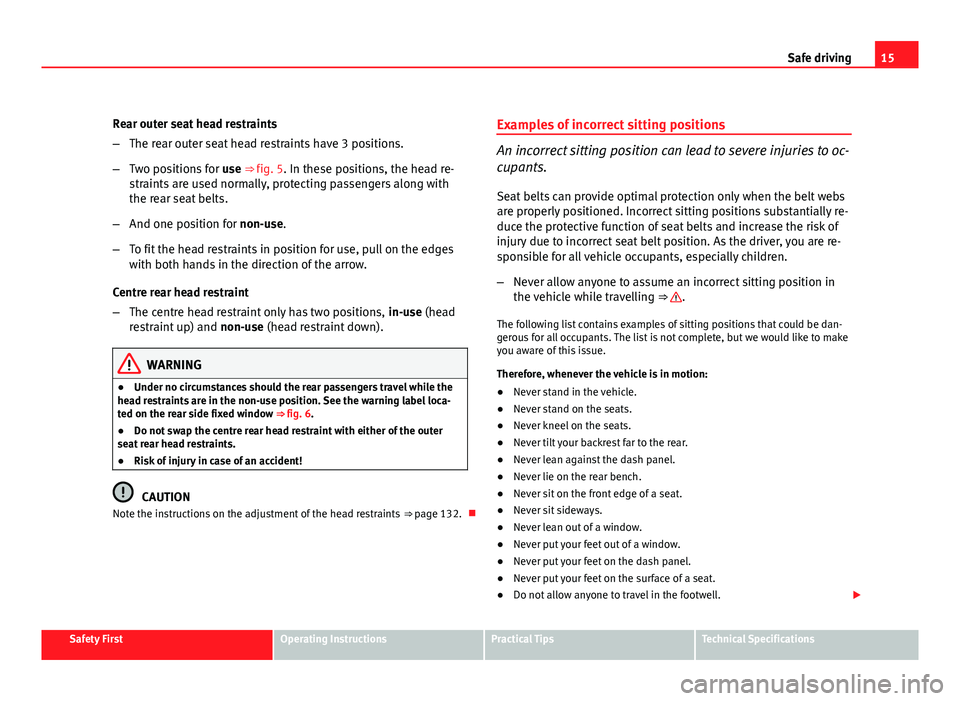
15
Safe driving
Rear outer seat head restraints
– The rear outer seat head restraints have 3 positions.
– Two positions for use ⇒ fig. 5. In these positions, the head re-
straints are used normally, protecting passengers along with
the rear seat belts.
– And one position for non-use.
– To fit the head restraints in position for use, pull on the edges
with both hands in the direction of the arrow.
Centre rear head restraint
– The centre head restraint only has two positions, in-use (head
restraint up) and non-use (head restraint down).
WARNING
● Under no circumstances should the rear passengers travel while the
head restraints are in the non-use position. See the warning label loca-
ted on the rear side fixed window ⇒ fig. 6.
● Do not swap the centre rear head restraint with either of the outer
seat rear head restraints.
● Risk of injury in case of an accident!
CAUTION
Note the instructions on the adjustment of the head restraints ⇒ page 132. Examples of incorrect sitting positions
An incorrect sitting position can lead to severe injuries to oc-
cupants.
Seat belts can provide optimal protection only when the belt webs
are properly positioned. Incorrect sitting positions substantially re-
duce the protective function of seat belts and increase the risk of
injury due to incorrect seat belt position. As the driver, you are re-
sponsible for all vehicle occupants, especially children.
– Never allow anyone to assume an incorrect sitting position in
the vehicle while travelling ⇒
.
The following list contains examples of sitting positions that could be dan-
gerous for all occupants. The list is not complete, but we would like to make
you aware of this issue.
Therefore, whenever the vehicle is in motion:
● Never stand in the vehicle.
● Never stand on the seats.
● Never kneel on the seats.
● Never tilt your backrest far to the rear.
● Never lean against the dash panel.
● Never lie on the rear bench.
● Never sit on the front edge of a seat.
● Never sit sideways.
● Never lean out of a window.
● Never put your feet out of a window.
● Never put your feet on the dash panel.
● Never put your feet on the surface of a seat.
● Do not allow anyone to travel in the footwell.
Safety FirstOperating InstructionsPractical TipsTechnical Specifications
Page 19 of 297

17
Safe driving
WARNING
● If the pedals are obstructed, an accident may occur. Risk of serious
injuries.
● Ensure that the floor mats are always securely attached.
● Never lay or fit floor mats or other floor coverings over the original
floor mats. This would reduce the pedal area and could obstruct the ped-
als. Risk of accident.
Storing objects Loading the luggage compartment
All luggage and other loose objects must be safely secured
in the luggage compartment.
Unsecured objects which shift back and forth could impair the driv-
ing safety or driving characteristics of the vehicle by shifting the
centre of gravity.
– Distribute the load evenly in the luggage compartment.
– Place heavy objects as far forward as possible in the luggage
compartment.
– Place the heavy objects first.
– Secure heavy objects to the fastening rings ⇒ page 18.
WARNING
● Loose luggage and other objects in the luggage compartment could
cause serious injuries.
● Always stow objects in the luggage compartment and secure them on
the fastening rings.
● Use suitable straps to secure heavy objects.
● During sudden manoeuvres or accidents, loose objects can be thrown
forward, injuring vehicle occupants or passers-by. This increased risk of
injury will be further increased if a loose object is struck by an inflating
airbag. If this happens, objects can be transformed into “missiles”. Risk
of fatal injury.
● Please note that the centre of gravity may shift when transporting
heavy objects; this may affect the vehicle's handling and lead to an acci-
dent. Therefore, it is essential to adjust your speed and driving style ac-
cordingly, to avoid accidents.
● Never exceed the allowed axle weights or allowed maximum weight.
If the allowed axle load or the allowed total weight is exceeded, the driv-
ing characteristics of the vehicle may change, leading to accidents, inju-
ries and damage to the vehicle.
● Never leave your vehicle unattended, especially when the tailgate is
open. Children could climb into the luggage compartment, closing the
door behind them; they will be trapped and run the risk of death.
● Never allow children to play in or around the vehicle. Close and lock
all the doors and tailgate when you leave the vehicle. Before you lock the
vehicle, make sure that there are no adults or children in the vehicle.
● Never transport passengers in the luggage compartment. All passen-
gers must have their seat belt fastened ⇒ page 19.
Safety FirstOperating InstructionsPractical TipsTechnical Specifications
Page 21 of 297
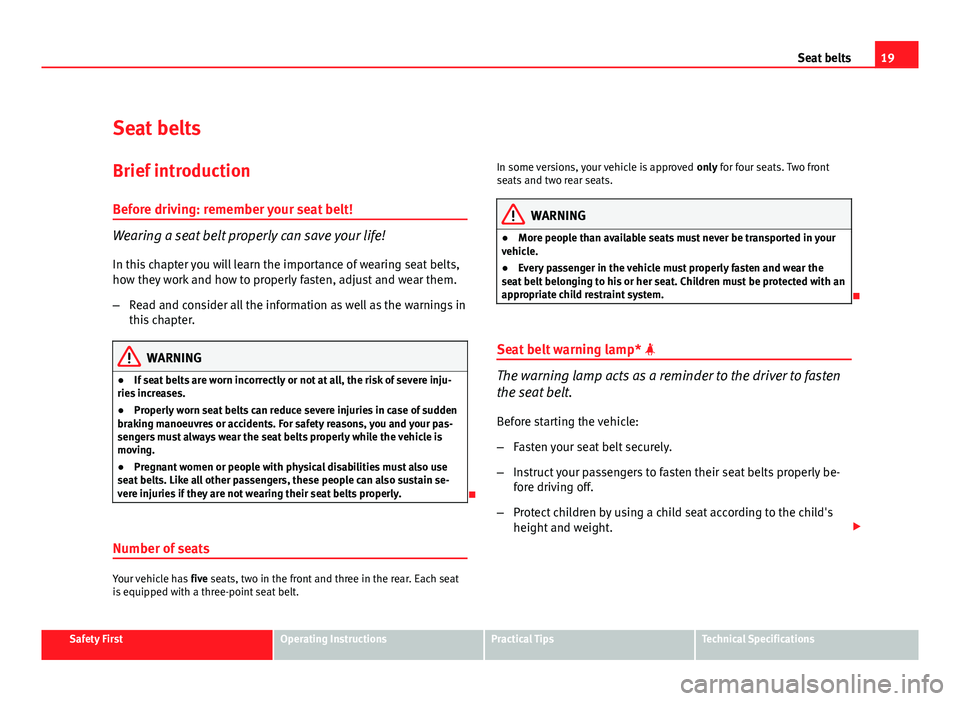
19
Seat belts
Seat belts
Brief introduction Before driving: remember your seat belt!
Wearing a seat belt properly can save your life!
In this chapter you will learn the importance of wearing seat belts,
how they work and how to properly fasten, adjust and wear them.
– Read and consider all the information as well as the warnings in
this chapter.
WARNING
● If seat belts are worn incorrectly or not at all, the risk of severe inju-
ries increases.
● Properly worn seat belts can reduce severe injuries in case of sudden
braking manoeuvres or accidents. For safety reasons, you and your pas-
sengers must always wear the seat belts properly while the vehicle is
moving.
● Pregnant women or people with physical disabilities must also use
seat belts. Like all other passengers, these people can also sustain se-
vere injuries if they are not wearing their seat belts properly.
Number of seats
Your vehicle has five seats, two in the front and three in the rear. Each seat
is equipped with a three-point seat belt. In some versions, your vehicle is approved
only for four seats. Two front
seats and two rear seats.
WARNING
● More people than available seats must never be transported in your
vehicle.
● Every passenger in the vehicle must properly fasten and wear the
seat belt belonging to his or her seat. Children must be protected with an
appropriate child restraint system.
Seat belt warning lamp*
The warning lamp acts as a reminder to the driver to fasten
the seat belt.
Before starting the vehicle:
– Fasten your seat belt securely.
– Instruct your passengers to fasten their seat belts properly be-
fore driving off.
– Protect children by using a child seat according to the child's
height and weight.
Safety FirstOperating InstructionsPractical TipsTechnical Specifications
Page 23 of 297

21
Seat belts
Why wear seat belts? Physical principles of frontal collisions
In the event of a frontal collision, a large amount of kinetic
energy must be absorbed.
Fig. 7 Vehicle about to
hit a wall: the occupants
are not wearing seat
belts
Fig. 8 The vehicle hits
the wall: the occupants
are not wearing seat
belts
It is easy to explain how the laws of physics work in the case of a head-on
collision: When a vehicle starts moving ⇒ fig. 7, a certain amount of energy
known as kinetic energy is produced in the vehicle and its occupants.
The amount of kinetic energy depends on the speed of the vehicle and the
weight of the vehicle and its passengers. The higher the speed and the
greater the weight, the more energy there is to be released in an accident.
The most significant factor, however, is the speed of the vehicle. If the
speed doubles from 25 km/h to 50 km/h, for example, the kinetic energy is
multiplied by four.
Because the passengers in our example are not restrained by seat belts, in
the case of a head-on collision all of their kinetic energy has to be absorbed
at the point of impact ⇒ fig. 8.
Even at speeds of 30 km/h to 50 km/h, the forces acting on bodies in a col-
lision can easily exceed one tonne (1000 kg). At greater speed these forces
are even higher.
Passengers not wearing seat belts are not “attached” to the vehicle. In a
head-on collision, they will move forward at the same speed their vehicle
Safety FirstOperating InstructionsPractical TipsTechnical Specifications